Tiempo Climate Cyberlibrary
Perceptions of Climate Change in the Himalayas
 |
Ngamindra Dahal describes how climate change
impacts are perceived locally in parts of the
Himalayas in Nepal, and proposes activities to reduce
vulnerability.
|
|
The author trained as a hydro-meteorologist. He
currently works as the Energy and Climate Change
Coordinator at the King Mahendra Trust for Nature
Conservation, a leading environmental
non-governmental organization in Nepal.
|
Ecological changes noticed in the high Himalayas
indicate that global warming will have a serious impact on
the lives and livelihoods of local communities. Communities
in the Mustang
and Manang Districts of Nepal have already
begun experiencing unusual changes in weather patterns.
Some of them are happy with these changes; for example,
farmers have noticed improved apple sizes in recent years.
But others face hardship; for example, water leakage into
traditional houses has increased, which people feel is due
to new precipitation patterns. These findings need to be
validated by scientific studies, but the urgency to support
affected communities is already clear. They need help to
enable them to respond to the new challenges posed by
climate change.
Most highland communities depend on cattle and sheep
farming and, therefore, have serious concerns over the
declining production of grass in the Himalayan grasslands.
This is mainly due to moisture deficiencies resulting from
reduced snow deposits. Local people have also noticed
spectacular changes in their surroundings in the last
couple of decades; hillsides that once used to be covered
in snow throughout the year are now bare and dry. Stream
flow and spring characteristics have changed dramatically
in recent years, making it challenging to manage water
supplies.
Local perceptions of changes
Many of the highland residents of Manang in the
Annapurna Range of the Himalayas have observed heavy
monsoon rains in recent years. This type of erratic monsoon
precipitation is a new phenomenon. Previously, monsoon
rains used to be of lower intensities and amounts, and
heavy monsoon rains only occurred at lower altitudes.
Intense rainfall has affected traditionally-built
flat-roofed houses made of mud and stone. Roof leakage and
wall erosion problems are a major concern for low-income
families who cannot afford to regularly repair their
houses.
|
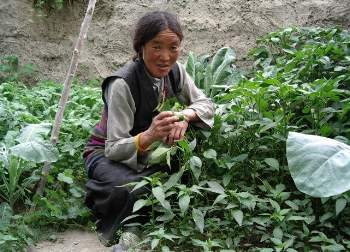
|
A farmer in her new
vegetable garden in Mustang, Nepal
© M Chetri
|
Narendra Lama, a conservation officer in Manang, says,
"problems from the leakage of rainwater through the
roofs of traditional mud houses have increased in recent
monsoons. The number of people seeking support from us to
repair their houses has suddenly jumped." The rooftops
are also traditionally designed to accumulate winter
snowfall for meeting domestic water needs. Decreased winter
snowfall could eventually lead to a shortfall in the
village water supply.
Some farmers in Mustang, the neighbouring district to
Manang, say that the changed climate has significantly
impacted their lifestyles. They are confident that the
climate has changed, not because they know much about
global warming or reports of rapidly receding Himalayan
glaciers, but because of their long experience with the
realities of the local environment. For most of them the
impact is positive. Farmers are growing new vegetables such
as cauliflower, cabbage, chili, tomato and cucumber, which
used to need greenhouses to survive. Local fruits have
better sizes and tastes. New plants that only used to grow
at lower altitudes can now be found. Many note the fact
that their Himalayan district is greener than it was a few
decades ago. Local residents say this is because of the
changing climate rather than technological inputs or
improved seed varieties.
Shenjing Gurung, a 53-year-old resident of Muktinath
Valley (located at an altitude of 3500m) in Mustang
District, is happy with the warming climate. He says
"I have not experienced a long chilly winter in the
last five or six years." Gurung is a mountain farmer,
and in addition to the relatively warm and snow-free
winters, he has noticed changes in the farming of
vegetables and crops. When asked whether the changes were
due to development interventions, Gurung says, "credit
for the new vegetable varieties partly goes to development
programmes that have been implemented over the last ten
years and partly to the change in climatic patterns. Better
tasting and larger apples are due to the climate."
|
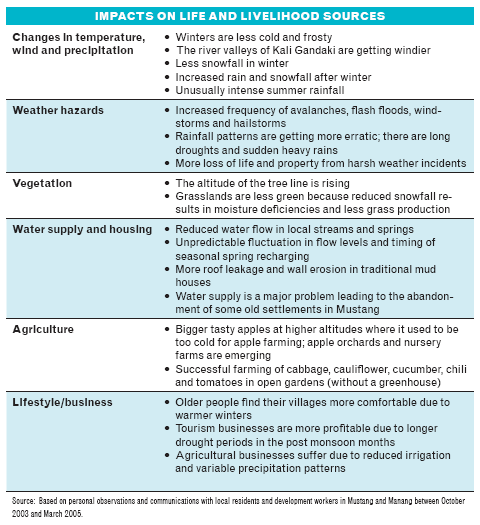
|
Climate change affects different crops in different
ways. These varying interactions between the climate and
crops shape the perceptions that farmers have about climate
change. For example, farmers engaged in apple farming
benefit from the warming climate while those traditionally
dependent on wheat, potato and other local crops and
vegetables have suffered. Similarly, families dependent on
tourism businesses benefit from the longer drought periods
following the monsoon, as this helps increase the numbers
of tourists visiting their areas. In contrast, some of
those running agricultural businesses suffer due to
variable precipitation patterns and reduced opportunities
for irrigation.
Elderly people believe that weather induced hazards such
as large avalanches, windstorms and hailstorms are
increasingly common. In the summer of 2003, a herd of 36
yaks was killed near Jomsom. "There is no doubt that
the region has warmed up in recent decades," says
former District Development Committee Chairman and local
businessman Nirmal Gauchan. He adds that the emerging
mosquito problem in the Jomsom Valley, located at an
altitude of 2700m, may be an indicator of the warming
climate.
The implications of local perceptions
In many cases, stories from local people confirm
findings from recent scientific studies, particularly about
shrinking snow cover and retreating glaciers. A study
conducted by the International Centre for
Integrated Mountain Development and the United Nations Environment
Programme in the year 2000 identified 3252 glaciers and
2323 glacial lakes in Nepal. An analysis of this inventory
suggested that twenty of these glacial lakes were
potentially dangerous. Excessive melting of glaciers
increases the size of lakes, which can eventually burst out
of their confines generating tremendous floods
downstream.
|
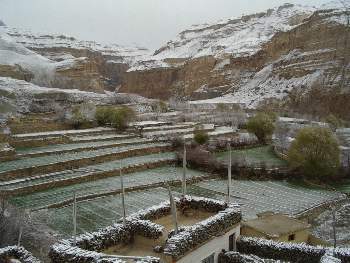
|
A traditional mud
house in Tsaile Village, Mustang District
© M Chetri
|
Meteorological data for Jomsom from 2002 to 2004 also
supports local views. Rainfall data indicates a decrease in
winter precipitation and an increase in rainfall after the
winter months. Snowfall in the post-winter season affects
crop farming, but people have a strong belief that current
changes in the rainy season are temporary and will
eventually revert back to how they used to be.
The local observations described above provide a clear
direction for future research and for development planning
and disaster management programmes in the high Himalayas.
More scientific studies are needed to validate these
observations. However, some research on climate change
impacts and the associated risks in mountainous regions has
been conducted. Some of this is discussed in the following
sections.
Melting glaciers and glacial lake outburst
floods
According to one recent study, Nepal’s temperature
is rising by about 0.41 degrees Celsius per decade. Another
study conducted in the vicinity of Tsho Rolpa Glacial Lake
in Dolakha District suggests that mean temperature is
increasing annually by 0.019 degrees Celsius with an
increase in average summer temperature of 0.044 degrees
Celsius. This is causing rainfall to increase by 13mm per
year, while the number of rainy days is decreasing by 0.8
days per year suggesting that rainfall occurs in bursts.
Consequently, river flow is increasing at
1.48m3/s per year, which is about 1.5 times
higher than increases in precipitation. High increases in
summer river flow provide further evidence that high summer
temperatures are leading to fast glacial melt.
|
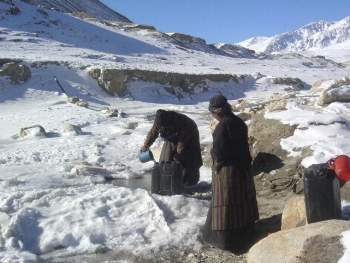
|
Local women from a
high Himalayan village fetch potable water from a
pond in winter
© M Chetri
|
The rate of glacial retreat reached up to 1.8m per year
in the 1970s and 2.4m per year in the 1980s. As a result of
fast glacial melt, new glacial lakes have formed and those
already existing have grown rapidly. This alarming highland
trend threatens downstream communities and the environment
due to the increased risk of glacial lake outburst floods.
The occasional bursting of glacial lakes in the past has
seriously damaged the lives and livelihoods of mountain
communities. Such threats operate in conjunction with other
changes to the patterns of river flow, spring water
recharge, precipitation and vegetation types expected as a
result of global warming in the Himalayas.
Rise in water-related hazards
Weather-related extreme events like excessive rainfall,
longer drought periods, landslides and floods are
increasing both in terms of magnitude and frequency. Mean
annual precipitation is increasing, as is the occurrence of
intense rainfall. This causes more erosion of soils and
riverbeds and banks, as well as sedimentation on fertile
land. More floods and glacial lake outbursts will destroy
irrigation and water supply systems, roads, bridges,
settlements and productive land. Flood-related deaths will
increase. Land degradation will reduce crop productivity
and put more pressure on remaining fertile land. In the dry
season, increased evaporation will lead to water scarcity.
Soil moisture deficits, droughts, fire and possible pest
outbreaks will decrease crop yields. Climate change will
have major impacts on ecosystems, land and water resources,
health, and major economic sectors such as agriculture.
Increasing mountain community vulnerability
The vulnerability of mountain dwellers is likely to
increase due to changes in rainfall patterns. Increased
water-related hazards and a shift in the rainy season will
affect household incomes, most of which depend on
subsistence farming. Health effects could include the
extension of ranges of vectorborne diseases such as malaria
and encephalitis to mountain settlements. Progress in
environmental management has been slow and natural resource
degradation remains at the core of many problems. Climate
change will add a new stress to ecosystems and
socioeconomic systems already affected by poverty, natural
resources depletion and unsustainable management practices.
Climate change impacts on land resources will make
management even more difficult if appropriate measures are
not taken.
|
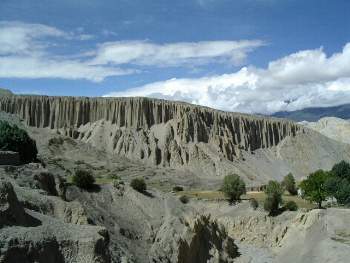
|
An erosion prone
landscape in the rain shadow part of the Himalayas
near Yara
© M Chetri
|
The looming water crisis
Mountains are a source of fresh water for the hills and
plains and are, therefore, considered ‘water
towers’. Erratic rainfall patterns means managing
water is more challenging. Prolonged light rains help
recharge groundwater but intense rainfall generates run off
which leads to floods and landslides. Nepal also faces
sedimentation problems. Widespread land degradation has
reduced productivity. Hundreds of human lives and
properties worth millions of rupees are lost every year to
floods and landslides. As snowfall declines, springs and
spring fed rivers show reduced flows. Water scarcity is
expected to increase in winter and in the dry season.
Conclusions and ways forward
Variations in precipitation patterns have impacts on
various aspects of local life. People report that these
impacts are both negative and positive. The much-discussed
issue of glacial melt is not a big concern for local
people; they are more concerned with the shifting
precipitation patterns and reduction in snow deposits that
provide water reserves for use in the summer. Inadequate
scientific monitoring makes it difficult to validate the
observed changes.
Climate change is recognized as a threat to communities
in the highlands and plains who depend on mountain
resources such as water. Surprisingly, many people feel
positive about climatic changes and are hopeful about the
future of the environment. They expect future winters to be
less chilly and summers to be humid and warm. The thought
of less harsh winters due to a decline in snowfall brings a
smile to the faces of elderly people, although some of them
also fear that reduced water supplies will be problematic.
However, most people are unaware of the real consequences
of global warming. Communities who are most vulnerable to
the affects of climate change are generally unaware of the
nature of possible impacts. They are, therefore, less able
to cope with changing situations.
Water management is undoubtedly the main challenge
regarding local responses to climate change impacts.
Reviving traditional practices and improving knowledge on
how to harvest rainwater and snowfall provides one way of
coping with this problem. Appropriate technologies,
suitable for the local context, are also helpful. Before
planning any interventions, a proper assessment of the
impact of climate change on water resources is
essential.
Empowering communities with information, technological
skills, education and employment is the best way to address
vulnerability. A sizable action-research project is
therefore necessary to identify and document climate change
impacts. Planning mitigation measures should also be a
priority.
Nepal demonstrates diverse geo-physical and climatic
conditions within relatively small areas. It is, therefore,
an ideal place to study climate change impacts on natural
and socio-economic spheres. Such a study would contribute
towards a better understanding of the intensity and impacts
of global changes. The first step in such a study would be
to start monitoring rainfall and temperatures at the
community level. Mobilizing local schools and communities
to monitor the weather using rain gauges and thermometers
could fulfill the dual purpose of enhancing local
scientific databases and raising the awareness of students
and other people about the importance of monitoring the
climate.
Further information
Ngamindra Dahal, King Mahendra Trust for Nature
Conservation, PO Box 3712, Kathmandu, Nepal. Fax: +977 1
5526570 Email: ndahal@kmtnc.org.np. Web:
www.kmtnc.org.np.
On the Web
The Tiempo Climate Cyberlibrary presents a listing of
websites on mountains and
climate.





